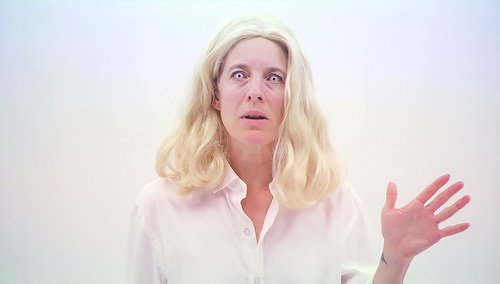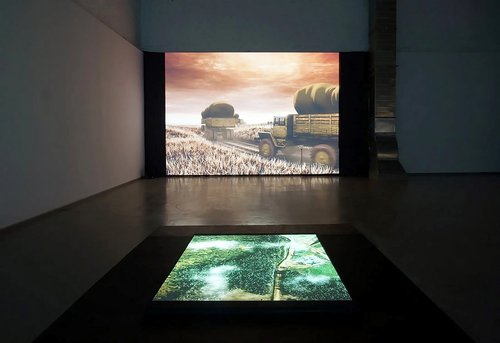Making Waves: Latvia’s Experimental Text-Group Orbita

Orbita. Logos, 2022. Still from the video. Presented at the PAiR Residence Gallery, Pāvilosta, 2022. Courtesy of the artists
Orbita is a Latvian collective of creative minds whose works span poetry, sound art and installation. This year Orbita celebrates its 25th anniversary and to mark this milestone in an exhibition ‘Grotto Far From the Sea’ at the Zuzeum Art Centre in Riga the collective has created an immersive poetic universe.
Rays of light, sound waves, radio waves, spinning fans blowing air, a gentle rocking, humming and knocking… these are the metaphorical brushstrokes or the conveyors of meaning that make up the gentle poetic universe created by Orbita for their anniversary exhibition ‘Grotto Far From the Sea’. Staged by Zuzeum, Riga’s most progressive contemporary art centre, it marks a quarter of a century since they were established, and it is not a retrospective. It presents what are on the face of it five quite modest works, these five entities – for not all are physical works – placed in an arrangement that evokes a secret grotto temple. There is a mesmerising universe of layered meanings and sensations that border on a religious experience.
Orbita call themselves a text-group. In its current formation, it comprises four members: Semyon Khanin (b. 1970), Artūrs Punte (b. 1977), Vladimir Svetlov (b. 1973), and Sergej Timofejev (b. 1970). They explore, tease and question the nature of text, specifically poetry in works that often veer far from the shape or form usually expected of a poem. For example, the collective’s work ‘Two Sonnets from Laputa’ consists of two walls of fourteen shelves, each displaying a miscellaneous array of bric-a-brac, every object on display standing for an imagined word in the sonnet format in Jonathan Swift’s imagined object language. Rhythm and rhyme are not verbal. Instead, they are conveyed by physical characteristics such as texture, colour and shape: a clock, a broken brick, a mousetrap, a sewing machine, a spice mill. Taken out of their everyday context these objets trouvés become a lexicon for each to decipher as they want.
This creates a mesmerising riddle, a challenge to convert these physical objects into poetic words and meanings or, conversely, to abstain from such an impulse.
“When I was writing it,” Khanin says of the process, “I got immense pleasure from the fact that I was thinking in a different language, which I had invented, where the correspondences were purely visual. It was fascinating. Although I might be seen as a logocentrist, this was such a nice liberation from conventional language.”
Teasing apart the space in between visual and textual desires calls on us to look inside that space where the formation of meaning and the understanding of poetics is conceived at the intersection between image sign and meaning.
The Orbita collective came about as an accident, says Khanin, who co-founded the group in 1999. Initially orbiting around a joint publishing project, the members shared a common interest in text, and its broader artistic potential. Thus, their collaboration evolved into a collective practice of experimental readings, performance, sound and video. Standing at the forefront of video poetry, they became responsible for the development of this genre in Latvia.
“We had not really understood how special this was at the time. We did not have the opportunity to know video poetry as a genre. There was a distinct feeling that this could and should be done,” recalls Timofejev, as quoted by Aiga Dzalve and Ilva Skulte in their book ‘Orbita’, describing the group’s first experience of layering poetry over 16mm footage of them roaming around an abandoned Riga submarine base.
Orbita’s poetic output is primarily in Russian, which, given the tensions surrounding language issues in the Baltic countries, may seem extraordinary today. They have a cult following among the Latvian-speaking progressive art crowd. In his book ‘Border Conditions’, Dr. Kevin M.F. Platt, Professor of Russian and East European Studies at the University of Pennsylvania, who has translated a number of Orbita texts and published academic articles about the group, calls this “the accomplishment of a political coup by intently apolitical means.”
The art of translation is not simply a tool but a focal element in many works and conceptual publications of the ‘Orbītas bibliotēka’ book series spearheaded by Khanin. The book ‘Par Mums’ (‘To Us’, 2009) is a case in point – Latvian poetry with Khanin’s Russian translation in a double-sided volume intended for bi-lingual couples to read simultaneously sitting opposite one another. It turns poetic text through publication into a communal embodied experience.
The most alluring and elegant object in the exhibition space is ‘Weight of Voice’. A self-portrait of sorts, this table-like structure consists of four horns emitting readings by the four Orbita member poets. The sound triggers slight movement in the tabletop, causing a group of balls on its surface to roll around unpredictably. A mysterious perpetuum mobile where poetic texts become the impetus for a kinetic sculpture, this looks like the invention of a fantasy sci-fi genius, with a steampunk vibe.
On Orbita’s obsession with retro gadgets, critic Kirill Kobrin in his article ‘Orbita: Analogue Retro-Utopian Things’, published in the Russian NLO magazine, coins the term ‘analoguepunk’ to describe “an analogue being that shaped the world before the digital revolution and continues to this day.” He compares this kind of retrofuturism with steampunk as it imagines a continued existence of outdated technologies in a parallel universe.
The current exhibition is steeped in this object nostalgia. Apart from the above-mentioned objects, the back wall of the exhibition space is devoted to ‘Radiowall’, a panoramic sound installation. Ninety multifarious radios are attached to the wall, creating a rhythmic display of Soviet and European design, punctuated by elegantly protruding antennae. However, the visual aspect is merely a vehicle for the sonic. All these gadgets transmit waves of local radio stations, cityscape recordings, experimental musical fragments and poetic readings. Like other works in the show, this is the reincarnation of a previous work (first created in 2012, re-staged several times and, since 2020, part of the collection of the Latvian National Museum of Art), representing the group’s ongoing fascination with radio waves and FM receivers. At one point they even set up a pirate radio station in Riga for one of the Survival Kit festivals organised annually by the Latvian Centre of Contemporary Art (LCCA) only for it to be uncovered eventually with the group incurring heavy police fine.
Just as valuable as their outdated materiality, these analogue transmitters of information deliver a romanticization of error and glitch, conveying nostalgia for the accidental, chaotic and imprecise as offered by the analogue medium. What is their appeal?
“These methods of delivering poetic texts, all these interferences, they demand more effort from the audience to perceive the text, so in a direct sense they make it more difficult, but in another sense, they demand more engagement and interaction,” says Khanin.
Walking away from the Zuzeum Grotto, its reverberations tilted my worldview. The sonnet riddles still lingered in my mind, fragments of poetry, grasped through the interfering crackle of radio waves, my own mindset had tuned into a poetic wavelength. There I was, looking for rhymes in supermarket shelves and everyday objects, listening to the poetry of fragmented, multi-lingual conversation mixed with the sounds of Riga in the rattling tram.














